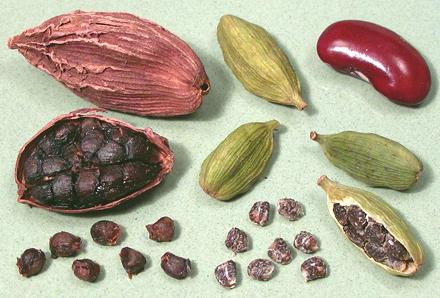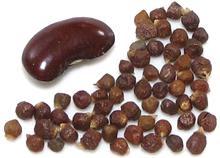
Green Cardamom (small pods in the photo) is native to India and Malaysia, with India producing nearly the entire world's supply. The seeds are highly aromatic with a sharp brilliant flavor. White cardamom is green that has been bleached. This is the cardamom to use whenever black is not specifically called for by name or region, and is the cardamom commonly available in Europe and North America.
Black Cardamom (large dark pods in photo) is not interchangeable with green cardamom. While the green is sharp and brilliant the black is dark and smoky with high tones of camphor and mint. It is the cardamom used in China and Vietnam, and in India it is used mostly in the Mughlai cuisine of the north. The Black Cardamom in the photo is the Chinese / Vietnamese species, which is quite a bit larger than the Indian species.
Cardamom spice is the seed pod and seeds of a member of the Ginger family (Zingiberaceae) native to India. It was known in ancient Egypt and mentioned in several medical papyri. It was also known in ancient Greece and in the Roman Empire as both a medicinal and culinary spice. Around 1000 years ago, Viking traders carried it to Scandinavia where it became quite popular and is still used today in many breads and pastries.
In the Arabic world and east through Persia and India it is used quite commonly to flavor coffee and tea, often as whole pods but also as seeds and powder.
Green Cardamom is the cardamom used for sweets from North Africa through the Middle East and India. In the Middle East and North Africa it is also very widely used as a flavoring for coffee and tea, and for tea in India. In Northern Europe and North America it is most commonly a flavoring for breads and other baked goods. In India it is widely used in curries and masalas (spice mixes), particularly for more refined dishes, while black cardamom is used for rustic and more spicy dishes.
Black Cardamom is used in the cuisines of China, particularly Sichuan, and also in Vietnam. In Sichuan it is used in long simmered recipes, particularly those featuring beef. In India it is included in garam masala spice mixes and in curries and pilaf, particularly in the Mughlai cuisine of northern India. It is almost never used in sweets but is often used in pickles.
White Cardamom is simply Green Cardamom that has been bleached. The green is highly preferable, especially if whole pods are used, as the bleaching process removes some of the flavor. In India, pods that are evenly bright green are sold that way at a higher price, and unevenly colored pods are bleached.
Buying & Storing: Preferably buy from a source that has a high turnover so the cardamom is fresh. Whenever possible buy whole pods - they keep their strength much longer and many Indian recipes call for whole pods. While husked seeds have a shorter shelf life than pods, ground cardamom degrades very rapidly.
As with all other spices store in a tightly sealed jar in a cool dry place away from sunlight. Figure on replenishing your supply of pods about once a year for freshness, and ground more frequently.
Cooking: If you have only ground cardamom and a recipe calls for pods, the accepted equivalent for green cardamom is 10 pods to 1-1/2 teaspoons ground. Keep in mind, ground is usually quite inferior as ground cardamom loses flavor very rapidly. When cooking with whole pods, they are usually very lightly crushed to allow liquid to pass through, but not so much that the seeds escape. In some parts of India the outer husk is peeled and the whole core added to the recipe.

Native to West Africa, this spice is rarely seen in North America
but some is grown in the Caribbean. It was important to 15th century
Europe but was completely replaced by black pepper by the 16th century.
Currently it is used in West and Central Africa and quite often used in
Morocco and Tunisia. The seeds are always ground and added near the end
of cooking. The photo specimens, about 0.12 inch (3 mm) were purchased
from an on-line spice vender in the United States. The best
substitute is probably Black Cardamom. On the islands
in the Gulf of Guinea the fresh fruits are eaten raw.

Native to Tanzania and western Ethiopia, this spice is very
important to the cuisines of Ethiopia and Eritrea. It is used in various
spice mixtures, such as berbere, mitmita, and awaze hot sauce. The pods
are smooth like green cardamom, but dark brown and about the size of
black cardamom pods. the photo specimens, about 0.17 inch long, were
purchased from an on-line spice vendor in the United States. The best
substitute is probably Black Cardamom, somewhat
different flavor, but in the ballpark.